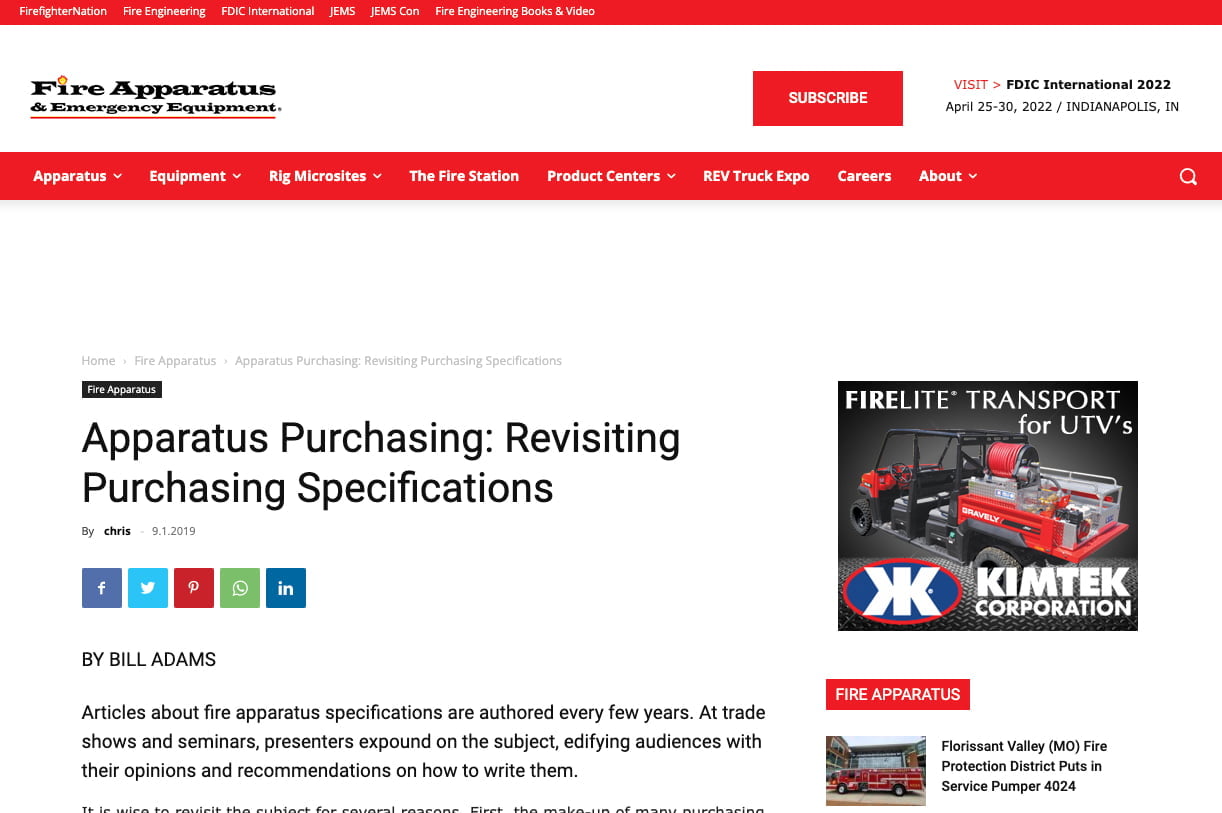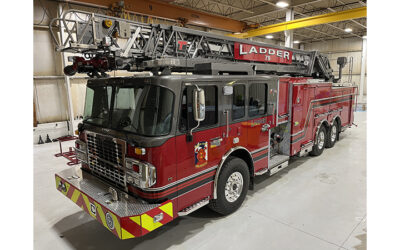By Bill Adams
A recent article in Fire Apparatus & Emergency Equipment, “Apparatus Purchasing: Revisiting Purchasing Specifications,” states that fire apparatus purchasing specifications should not be an educational tool for an apparatus purchasing committee (APC). The APC’s investigative and product comparisons for component parts should be done before the purchasing document is published.
There is no logical justification for a purchaser to explain each infinitesimal feature of a component part, how it works, and why it is being specified. That rationalization should be done at a committee level. At the same time, it is not the APC’s job to explain to potential bidders how each widget specified works. If bidders don’t know their product offerings, they are in the wrong business.
Almost all component manufacturers publish preferred specifications they encourage potential purchasers to include in their purchasing documents. Preferred specifications are an excellent resource for APCs to evaluate various products. After the evaluation process, when the APC chooses a component part, it is not necessary to use the preferred specifications in the purchasing document. In most instances, a make and model number should suffice. Four examples follow.
- One specification reads: “The air compressor provided for the engine shall be a Wabco® SS318 single cylinder pass-through drive type compressor which shall be capable of producing 18.7 CFM at 1200 engine RPMs. The air compressor shall feature a higher delivery efficiency translating to more air delivery per horsepower absorbed. The compressor shall include an aluminum cylinder head which shall improve cooling, reduce weight, and decrease carbon formation. Superior piston and bore finishing technology shall reduce oil consumption and significantly increasing the system component life.”
Eighty-two words are used above. Thirteen words are used here: “The air compressor provided for the engine shall be a Wabco® Model SS318.”
- Eighty five words are used to describe the Q: “The siren shall be an electro mechanical Federal Q2B™ siren, which shall be streamlined, chrome plated, and shall produce 123 decibels of sound at 10.00 feet. The Q2B™ siren produces a distinctive warning sound that is recognizable at long distances. A unique clutch design provides a longer coast down sound while reducing the amp draw to 100 amps. The siren shall measure 10.50 inches wide X 10.00 inches high X 14.00 inches deep. The siren shall include mounting hardware designed to recess or flush mount.”
“The siren shall be a chrome-plated Federal Q2B” uses nine words.
- Four hundred and twenty-two words are used to describe roll-up doors: “The vehicle shall be equipped with R•O•M Series IV roll-up exterior compartment doors. The R•O•M roll-up doors shall be complete with the following features:Each shutter slat, track, bottom rail, and drip rail shall be constructed from anodized 6063 T6 aluminum. Shutter slats shall feature a double wall extrusion 0.315” thick with a concave interior surface to minimize loose equipment jamming the shutter door closed. Shutter slats shall feature an interlocking end shoe to prevent side to side binding of the shutter door during operation. Slats must have interlocking joints with an inverted locking flange. Slat inner seal shall be a one piece PVC extrusion; seal design will be such to prevent metal to metal contact while minimizing dirt and water from entering the compartment.
Shutter door track shall be one piece design with integral overlapping flange to provide a clean finished look without the need of caulk. Door track shall feature an extruded Santoprene rubber double lip low profile side seal with a silicone co-extruded back to reduce friction during shutter operation.
Shutter bottom rail shall be a one piece double wall extrusion with integrated finger pull. Finger pull shall be curved upward with a linear striated surface to improve operator grip while operating the shutter door. Bottom rail shall have a smooth contoured interior surface to prevent loose equipment from jamming the shutter door. Bottom rail seal shall be made from Santoprene; it will be a double “V” seal to prevent water and debris from entering compartment. Bottom rail lift bar shall be a one piece “D” shaped aluminum extrusion with linear striations to improve operator grip during operation. Lift bar shall have a wall thickness of 0.125”. Lift bar shall be supported by no less than two pivot blocks; pivot blocks shall be constructed from Type 66 Glass filled reinforced nylon for superior strength. Bottom rail end blocks shall have incorporated drain holes which will allow any moisture that collects inside the extrusion to drain out.
Shutter door shall have an enclosed counter balance system. Counter balance system shall be 4” in diameter and held in place by two (2) heavy duty 18 gauge zinc plated plates. Counter balance system shall have two (2) overmolded rubber guide wheels to provide a smooth transition from vertical track to counter balance system; no foam material of any kind shall be permitted or used in this area.
All exterior compartment doors shall have the standard 3.0″ tall bottom rail extrusion for easy one (1) hand opening and closing.”
Fifteen words in the first sentence does the same thing: “The vehicle shall be equipped with R•O•M Series IV roll-up exterior compartment doors.”
- “There shall be a FoamPro 1600 foam system” uses eight words. Only a portion of these preferred specs encompass 458. “There shall be a FoamPro 1600 foam system with a 12 volt, 1/3 hp electric motor driven positive displacement piston type foam concentrate pump with a rated capacity of .01 to 1.7 gpm @ 200 psi, with operating pressures up to 400 psi. The system will draw a maximum of 30 amps @ 12 VDC.The apparatus shall be equipped with an electronic, fully automatic, variable speed, direct injection, and discharge side foam proportioning system. The system shall be capable of handling Class A foam concentrate. The foam proportioning operation shall be based on direct measurement of water flows, and remain consistent within the specified flows and pressures. System must be capable of delivering accuracy to within 5% of calibrated settings over the advertised operation range when installed according to factory standards. The system shall be equipped with a control module suitable for installation on the pump panel. Incorporated within the motor driver shall be a microprocessor that receives input from the system flowmeter, while also monitoring foam concentrate pump output. This compares values to ensure that the operator’s preset is proportional to the amount of foam concentrate injected into the discharge side of the fire pump.
A paddlewheel-type flowmeter shall be installed in the discharge system specified to be “foam capable.” A simulated flow feature shall be incorporated into the motor driver to simulate an approximate flow value of 100 gpm. This feature is to be engaged or disengaged with a momentary switch and will automatically disengage when the main system switch is turned off.
The control module shall enable the pump operator to:
Activate the foam proportioning system
• Select proportioning rates from 0.1% to 1.0%
• See a “low concentrate” warning light flash when the foam tank runs low and in two minutes, if foam concentrate is not added to the tank, shut the foam concentrate pump down.A 12 or 24-volt electric motor driven positive displacement plunger pump shall be provided. The pump capacity shall be from 0.1 gpm (0.38 L/min) to 1.7 gpm (6.4 L/min) at 200 psi (13.8 BAR) with a maximum operating pressure up to 400 psi (27.6 BAR). The pump shall have the capability to draw 3 foot of lift. The system will draw a maximum of 30 amps @ 12 VDC or 15 amps @ 24 VDC. The motor shall be controlled by the microprocessor (mounted to the base of the pump). It shall receive signals from the control module and power the 1/3 hp (.25 kW) electric motor in a variable speed duty cycle to ensure that the correct proportion of concentrate is injected into the water stream. A full flow check valve shall be provided in the discharge piping to prevent foam contamination of fire pump and water tank.”
Purchasing specifications are used to describe an item to be bought. They should not be used as a promotional endorsement of a particular product. Convincing or selling an APC to specify component parts should be done before the bid. If the members of an APC do not know why they are specifying an item, how it works, or what its advantages are then perhaps they do not belong on the committee. Component parts available to all apparatus manufacturers can be specified by a make and model number. Optional add-ons to the component part(s) such as colors and capacities and mounting locations if required should be noted. More later.
BILL ADAMS is a member of the Fire Apparatus & Emergency Equipment Editorial Advisory Board, a former fire apparatus salesman, and a past chief of the East Rochester (NY) Fire Department. He has 50 years of experience in the volunteer fire service.






